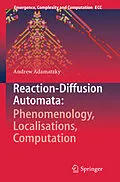Reaction-diffusion and excitable media are amongst most intriguing substrates. Despite apparent simplicity of the physical processes involved the media exhibit a wide range of amazing patterns: from target and spiral waves to travelling localisations and stationary breathing patterns. These media are at the heart of most natural processes, including morphogenesis of living beings, geological formations, nervous and muscular activity, and socio-economic developments.
This book explores a minimalist paradigm of studying reaction-diffusion and excitable media using locally-connected networks of finite-state machines: cellular automata and automata on proximity graphs. Cellular automata are marvellous objects per se because they show us how to generate and manage complexity using very simple rules of dynamical transitions. When combined with the reaction-diffusion paradigm the cellular automata become an essential user-friendly tool for modelling natural systems and designing future and emergent computing architectures.
The book brings together hot topics of non-linear sciences, complexity, and future and emergent computing. It shows how to discover propagating localisation and perform computation with them in very simple two-dimensional automaton models. Paradigms, models and implementations presented in the book strengthen the theoretical foundations in the area for future and emergent computing and lay key stones towards physical embodied information processing systems.
Inhalt
Part I Phenomenology and localisations.-
Part II Population dynamics.-
Part III Computation with excitation.
